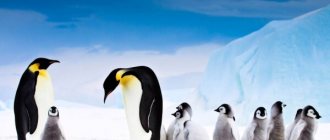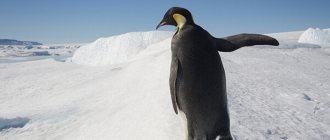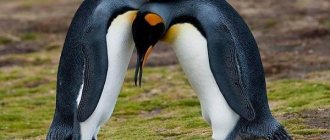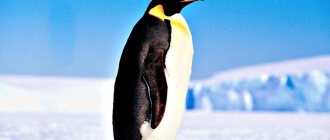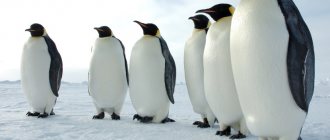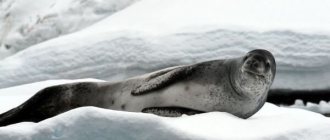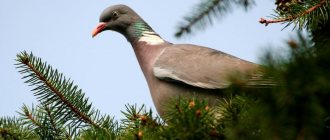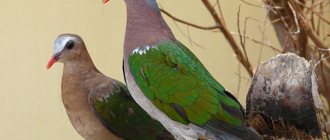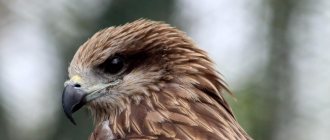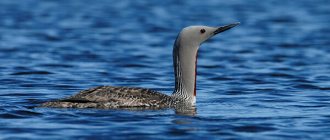- Wild animals
- >>
- Birds
The little penguin is the smallest of all penguins existing on earth. In various literary sources they are found under different names - blue penguin, elf penguin, fairy penguin. The local population considers the animal to be their symbol and practically worships it. Scientists and researchers for a long time very closely monitored these representatives of flora and fauna, studied their lifestyle and habits. Zoologists have come to the conclusion that they are characterized by extraordinary energy and mobility, which most penguins do not possess.
Origin of the species and description
Photo: Little Penguin
The little penguin is a representative of the animal kingdom, phylum chordata, class of birds, order Penguinaceae, family penguinaceae, genus and species Little penguins.
The historical homeland of modern blue penguins, like all others, is the southern hemisphere. Archaeologists were able to discover the remains of the ancient ancestors of modern penguins in the territory of modern New Zealand, South America, Africa, and the Galapagos Islands.
Video: Little Penguin
The most ancient finds indicate that these representatives of flora and fauna existed on earth during the Eocene period, approximately 45-43 million years ago. The ancient ancestors of modern birds had much larger body sizes. The largest representative was described by zoologist, researcher Norskjöld, after whom the penguin was named. His height was slightly higher than that of a human, and his body weight was 120 kilograms. Scientists do not rule out that the very first, primitive ancestors of modern penguins existed about 100 million years ago.
Penguins, which existed several tens of millions of years ago, were practically no different in appearance from modern individuals. The main difference was that the ancient ancestors of modern blue penguins could fly. Modern inhabitants of the southern hemisphere are most similar to tubenoses. After many studies, scientists came to the conclusion that they could have common ancestors.
penguin-2204566_1920.jpg
Photo from pixabay.com
What threatens penguins?
Today, three species of penguin are on the verge of extinction: crested, magnificent and Galapagos, and seven more species are in danger. Thus, Antarctic species suffer from melting ice, New Zealand and Australian penguins are attacked by wild mammals, such as cats and dogs, brought by people. Penguins living near a port in South Africa have been exposed to oil pollution, and the Galopogos penguin population has been reduced by travelers feeding on the birds' eggs.
Appearance and features
Photo: Little Blue Penguin
The little penguin has a very specific and memorable appearance. Sexual dimorphism in this bird species is insignificant. Male individuals are slightly larger than females. The average body weight of one adult individual is 1.3-1.5 kilograms. The length of the body does not exceed 35 centimeters. The body is painted in several colors at once.
The upper part of the head and the back area are colored dark blue, rather blue. The inner surface of the head, neck and abdomen are painted white. The forelimbs in the process of evolution were transformed into flippers. The average length of the upper limbs is 111-117 millimeters. They are black in color. It is with the help of these flippers that penguins are able to stay in the water for quite a long time and swim quickly. In the area of the ears, the body is dark, almost black.
Penguins have a small, round head. It has an elongated beak no more than 5 centimeters long and small, round eyes. The iris of birds is colored hazel or blue with a gray tint. The beak is dark brown, chestnut color. The lower limbs are pink on top and three-toed. The fingers have thick, sharp, rather long claws. There are membranes between the toes of the lower limbs that help birds swim. The soles of the lower limbs are painted black.
Interesting fact: As individuals grow older, their beaks and the color of the plumage in the back area darken.
The average lifespan of birds in natural conditions is 6-7 years. In artificial conditions, with sufficient food and good care, life expectancy can triple. Little penguins, like other representatives of the species, have very thick plumage. They are protected from the cold by an oil layer and subcutaneous fat. Blue penguins, like all representatives of this family, have a small, rounded tail.
Curious facts
- Penguins even caught dinosaurs, because they appeared about 70 million years ago. For a long period, penguins belonged to a separate group of animals, and only recently have researchers identified the family of these birds. Based on these studies of their DNA, the penguin is a species of seabird (albatross, petrel, loon).
- The penguin is one of 40 species of flightless birds, including emus, ostriches, kiwis, and cassowaries.
- This is the only bird that can swim, but cannot fly. It is also the only bird that walks standing.
- A unique way for birds to move through loose snow. In order not to fall through when walking, the penguin lies on its stomach, pushes off the snow with its paws and wings, thus sliding at a speed of up to 25 kilometers per hour.
- Emperor penguins cooperate to stay warm, gathering in close groups. Inside them, the temperature reaches +35 °C, despite the fact that the surrounding air is +20 °C.
- The Gentoo penguin is the fastest penguin. While swimming, it picks up speed up to 36 km/h. It is noteworthy that these representatives have pink litter.
- During the molting period, this bird sheds many feathers at once. During this time, they cannot swim, and therefore remain without food until new feathers grow.
- A penguin can stay underwater for up to half an hour. Birds spend half their life in water. The best divers are king penguins, which dive to depths of 100-500 meters.
- The movement speed of birds is essentially only 1-2 kilometers per hour. However, they can travel up to 100 km without stopping.
- The Patagonian penguin is able to swim for 2-3 weeks, covering a distance of 1.5 thousand kilometers.
- The webbed feet of these beauties are located at the end of the body, which is why penguins manage to stand upright. In winter, the female lays 1 egg and goes far towards the sea, while for 2 months the male guards her, while being practically immobilized.
- These birds stay in the ocean up to 75% of the time, but their offspring breed on ice floes or on the shore.
- Researchers from the Argentine Research Council were able to prove that some couples of the Magellanic genus did not separate for 16 years. Scientists have found that penguins are the most faithful of all living creatures.
- The emperor penguin can withstand 60-degree frost.
- The majority of penguin species (13 out of 17) are either endangered or seriously endangered.
Where does the little penguin live?
Photo: Little penguin in nature
Populations of these amazing birds are distributed in various parts of the southern hemisphere.
Geographic regions of distribution of little penguins:
- South America;
- Chile;
- Australia;
- Tasmania;
- New Zealand;
- Philippines.
The favorite habitat of birds is the territory of beaches, where it is easier for them to get food and hunt mollusks and crustaceans. Today, information about new bird populations continues to emerge in different parts of the southern hemisphere. In some cases, eyewitnesses note that penguins live close to human settlements. A prerequisite for habitat is the presence of a body of water. Birds live on land, but they swim well and get food exclusively in water.
Blue penguins lead a predominantly sedentary lifestyle. They tend to build nests in which they raise their chicks. They make nests in inaccessible, hidden places - crevices, burrows, caves, in dense thickets of bushes, under stone formations. Most populations live on the rocky coast, in savannas, and in bushes.
It is worth noting that penguins spend the vast majority of their personal time in the water. They return to their nests only after dark, so as not to reveal their location to predators. Sometimes, if there is not enough food, they can migrate to other regions, sailing quite far from the coast.
Now you know where little blue penguins live. Let's see what they eat.
dmitriy_rezvov-577423.jpg
Photo: Dmitry Rezvov
Where do penguins live?
Penguins live exclusively in the Southern Hemisphere. They can usually be found in the southernmost regions of Africa and South America, Australia and New Zealand. As lovers of colder climates, penguins live in latitudes with cold ocean currents: there they feel most comfortable and do not have problems finding food. A thick layer of fat and water-repellent feathers help them retain heat.
The northernmost and “heat-loving” species of penguin is the Galapagos penguin, which lives in the Galapagos archipelago near the equator. However, the main reason for such a long-distance settlement of this penguin is the flow of the cold Humboldt Ocean Current, which comes from Antarctica itself.
Penguins usually “settle” in large colonies, the number of individuals in which can reach several tens of thousands of pairs. Moreover, the life expectancy of these birds is on average 25 years.
What does the little penguin eat?
Photo: Little penguins
The main source of food for little penguins is marine life, mainly fish. They spend most of their time in the water. When a new day comes, they go into the water to get food and return only in the evening.
What serves as the food source for little penguins:
- small fish;
- shellfish;
- crustaceans;
- anchovies;
- octopuses;
- oysters;
- plankton;
- sardines.
Due to their size, blue penguins are able to dive to a depth of about two meters. The average duration of immersion under water is about twenty seconds. The record dive for representatives of this species is 35 meters, and the maximum duration under water is 50 seconds.
Animals have good eyesight, which serves as a guide in the underwater kingdom. The streamlined body, the presence of flippers and membranes on the hind limbs allows it to reach speeds of up to 5-6 km/h in pursuit of prey.
Birds are characterized by group hunting. Often at dawn you can see how they plunge into the water in large groups and then return back together. In the water, several individuals can simply attack a school of swimming fish and grab everyone they can. If the fish or shellfish are quite small, penguins eat them directly in the water. They drag larger prey onto land and divide it into parts.
Penguins are not afraid of cold weather and bad weather and feel comfortable in the water even in the cold season. In search of the required amount of food, they can travel several tens of kilometers. Penguins require a large amount of strength and energy for numerous dives, which sometimes require several dozen.
Is it possible to buy a live penguin in Russia?
Penguins are sold in specialized nurseries, but Russia does not have any. Meanwhile, there are organizations in the state that offer delivery of exotic birds from Europe. You can purchase this animal of any variety if you wish. Sometimes you can find advertisements for the sale of these pets on thematic websites.
It makes sense for residents of Russia to pay attention to the Galapagos species. The homeland of these penguins is not Antarctica, but warm countries such as South America and South Africa. It is precisely this species of bird that is most adapted to the climatic conditions of Russia.
Thus, you can buy an exotic friend in the following places:
- nursery;
- zoo;
- websites, advertisements.
Features of character and lifestyle
Photo: Little Blue Penguin
It is believed that elf penguins are nocturnal birds. However, when morning comes, they go to sea and return only late in the evening.
Birds lead a sedentary lifestyle, and, occupying a certain territory, nest and live on it for most of their lives. They are very jealous of protecting their habitat. Before attacking an uninvited guest, the little penguin warns him and only then attacks. If someone invades his domain and comes within two meters, he spreads his wings and screams loudly, piercingly, warning of his readiness to defend his habitat.
Interesting fact: Despite their small size, little blue penguins are considered very noisy birds. In the process of protecting their habitat, communicating between individuals of the group with each other, in pairs with each other, they often make very loud sounds, flapping their wings, etc.
During the breeding and breeding season, birds swim from the coastline an average of 10-13 kilometers and continue searching for food for 9-12 hours. They almost never move further than 20 kilometers from the coastline, except in cases of acute food shortage. Most often they come ashore from the water in the dark. This way you are less likely to become victims of predators.
Penguins spend a very large part of their time grooming their plumage. In the tail area there are special glands that secrete fat. Birds use it to lubricate their feathers so that they do not get wet in water.
Dangers
The main predators dangerous to Little Penguins are dogs, weasels, rats, foxes and cats. Pacific gulls and king skinks (large lizards) eat the eggs and young of little penguins. At sea, adult Little penguins often become prey for sharks, seals and killer whales.
According to a study conducted by the South Australian Institute, the number of penguins is noticeably declining due to the fault of long-nosed fur seals. The remains of these lovely birds were found in 40% of their litter. In the coastal region, penguins are often attacked by dogs and wild cats. Such attacks have been seen in the area of Tasmania, New Zealand, and on Kangaroo Island. The government is introducing rules to create dog-free zones and practice walking pets only with collars. Plus, volunteers patrol fairy penguin habitat areas at night to protect their population.
The second danger, in addition to predatory animals, was people and the products of processing their resources. There are known cases of human cruelty towards little penguins, their nests and chicks. The fact of shelling of penguin colonies in 1949 on Phillip Island is documented; in subsequent years, on other islands, penguins were beaten and chicks were pulled out of their nests, trampling their homes.
Penguins also often became entangled in fishermen's nets and died. There is a famous case involving fishermen where a colony of penguins was shot and cut into pieces to serve as bait for lobster fishing. Fishing is currently prohibited near penguin colonies.
Third, but no less dangerous for penguins, is environmental pollution. In particular, the entry of oil into the coastal waters of the ocean, fragments of plastic, which can damage the respiratory tract or stop the stomach.
Relationships with people
The Penguin Parade is very popular among tourists. 500,000 tourists visit Phillip Island (Australia) every year to watch the penguin parade as they enter and exit the water.
There are many organized penguin watching tourist spots in New Zealand. People come to watch Little Penguins return to their nests at dawn, raise their chicks and live in colonies.
This particular species of penguin is of great interest to scientists due to its small size and the large amount of energy it needs to survive, especially in cold temperatures. Studying Little penguins, scientists compare them with other animals - endotherms.
Observation platforms similar to Philip's have also been created on the Otago Peninsula (New Zealand), on Kangaroo Island. Granite Island in South Australia offers guided tours in the evening. In Western Australia, on Penguin Island, tourists can see penguins being fed and cared for at a rehabilitation center. At the same time, visitors must leave the island on time, without waiting for sunset, so as not to scare away the birds.
The smallest penguin in the world - Little Penguin
Interesting facts about Little Penguins:
- Little penguins are the most numerous (in one mating season) of all penguin species. They can have up to 6 chicks.
- On the website https://www.penguins.co.nz/new-zealand/ you can “adopt” a Little Penguin chick for a year - it costs $150, the creators of the site promise to send reports on their research and photos of the adopted penguin. You can also sponsor the construction of nests for Little Penguins, the cost of participation is from $30.
- The little penguin is the most nocturnal of all penguin species. During the day, these penguins rest, and at night they communicate and hunt.
- Special plumage protects Little Penguins from the cold. The hard outer shell of feathers protects against wind, and penguins use oil from a gland near their tail to waterproof the outer part of their feathers. The inside of the feathers, covered with soft, dense down, prevents cold air from penetrating.
- The graphic image of the Little Penguin, Tux, became the official mascot of Linux. Linux creator Linus Torvalds met these birds while on vacation in Australia.
Social structure and reproduction
Photo: Little penguin family
Males tend to attract females through certain sounds. They stretch their necks, fold their wings behind their backs and make a very drawn-out sound, similar to a squeal. Blue penguins tend to create monogamous, strong and very durable pairs.
The breeding season occurs in the summer season and lasts from early June to mid-September. During this period, birds nest and find especially secluded places - in rock crevices, under stones, in steep places. In one group, the distance between nests from each other is on average 2-2.5 meters. During the period of reproduction and breeding, this distance is significantly reduced.
After pairing and mating, the female lays eggs in her nest. During one clutch, she lays 1-3 white eggs weighing 50-55 grams. The eggs are then incubated for 30-40 days. The expectant mother incubates the eggs most of the time. Males replace their mates at the post every 3-4 days so that the females can go to sea and refresh themselves.
A month later, chicks hatch from the eggs. Newborn penguin chicks weigh 35-50 grams. Their bodies are covered with fluff. They remain in the parent's nest for quite a long period of time. For almost an entire month, the female and male provide food for their offspring. Then, gradually, the chicks go with the adults to the sea to independently obtain their own food. Over the next month, the female and male take care of the safety of their offspring.
When newborns reach a weight of approximately 900-1200 grams, they become independent and are ready for independent living. Penguin chicks reach sexual maturity at the age of 3 years. Penguins of this species are characterized by more productive reproduction with increasing age. It has also been scientifically proven that the better food penguins are provided with, the more fertile they will be.
Lifestyle and habitat
The king penguin lives in the northern part of Antarctica. Its homeland is small islands with a temperate climate near Antarctica and islands near Tierra del Fuego. There they gather in colonies, live, and reproduce. They can sometimes be found in southern Chile and Argentina.
On land they move awkwardly on two legs, helping themselves with small wings, like hands. But in the sea they are surprisingly mobile. Their streamlined body helps them swim quickly through rough seas. They dive and swim to the surface even in the most severe storms. The purpose of their swims is hunting.
They catch prey in the water - various fish, crustaceans and soft-bodied animals. They usually hunt alone, but prefer to live in groups. Discipline and hierarchy are observed in the colony. The best place is in the center, it is very warm and safe.
It is important for these birds to live on land, but have open access to the sea. The most dangerous enemies in nature for them are leopard seals, seals and killer whales. The cubs may be attacked by brown skuas or petrels. But even more terrible and dangerous for them was the man who hunted them for their blubber and meat, and partly for their skin.
Once a year they molt. New feathers seem to push the old ones out of his “fur coat”. Then the birds do not swim and wait out the molt in a secluded place. At this point they are forced to starve.
Natural enemies of the little penguin
Photo: Little penguins in nature
To minimize the risk of predation, penguins go to sea at dawn, when it is still dark. They return to their home when the sun has already set and it is already dark. However, despite this, they all have a sufficient number of enemies in natural conditions.
Penguin enemies include:
- sharks;
- seals;
- killer whales;
- slaty gulls;
- dogs;
- caresses;
- rats;
- foxes;
- cats;
- some types of lizards.
Man and his activities also contribute to the reduction in the number of fairy penguins. The constant pollution of their natural habitat, the release into the seas and oceans of a large amount of various waste, garbage, and products of the oil refining industry, reduces the territory of their habitat. Birds are very sensitive to pollution of their environment, including water bodies in which they obtain food for themselves and their offspring.
Fishing on an industrial scale leads to depletion and impoverishment of the food supply of animals. Penguins travel considerable distances in search of food. The problem of searching for food supply is especially pressing during the breeding season, when adult individuals must feed not only themselves, but also their offspring. A large number of these small, amazing birds live in zoos in different parts of the world.
What does the cost depend on?
The price of such an unusual pet is influenced by a number of factors:
- health status;
- size, weight;
- age;
- breed;
- cost of delivery;
- seller's pricing policy.
Anyone who wants to buy a real penguin needs to have a certain amount:
- from 50 thousand rubles – purchase at the capital’s zoo;
- from 250 thousand rubles – delivery from a US nursery;
- from 400 thousand rubles – purchase from a nursery in Europe.
